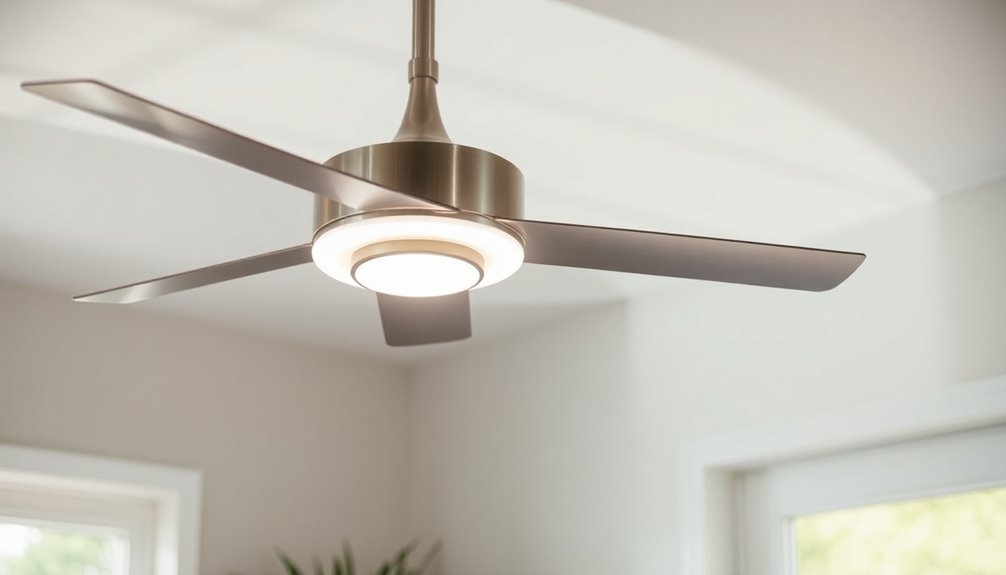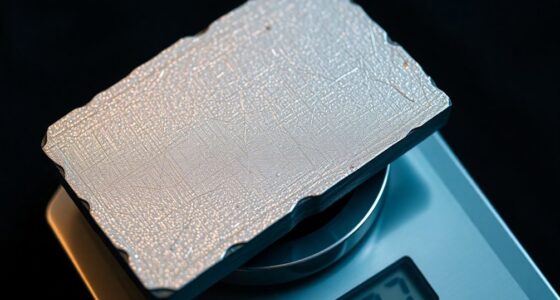Ceiling fans usually consume between 30 and 100 watts, depending on their size and efficiency. Energy-efficient models can run on as little as 30 watts, while larger fans may use up to 100 watts. The average fan typically draws about 75 watts. To find your fan's specific wattage, check the label or user manual. Remember, using fans strategically can lower your energy costs considerably. Factors like fan size and speed settings play a big role in wattage consumption. If you're looking to optimize your cooling and savings, there's more valuable information to explore.
Key Takeaways
- Standard ceiling fans typically consume between 55 to 100 watts, with an average wattage around 75 watts.
- Energy-efficient ceiling fans can operate using as little as 30 watts, significantly reducing energy costs.
- Fan size affects wattage; 30-inch fans use about 48 watts, while larger 60-inch fans may exceed 100 watts.
- Operating fans at low speed can reduce power usage by 20-30%, enhancing energy efficiency.
- Regular maintenance, like cleaning the blades, can save an additional 10% on energy bills.
Understanding Ceiling Fan Wattage
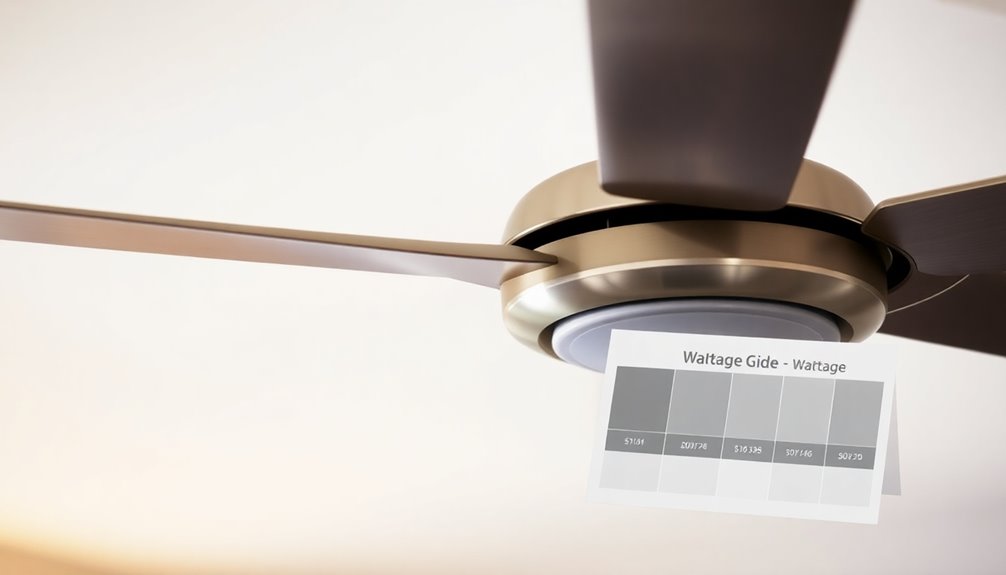
When you're considering a ceiling fan, have you thought about its wattage? Understanding the wattage of your ceiling fan is essential for managing power consumption and optimizing cooling efficiency in your home.
Standard ceiling fans typically consume between 55 to 100 watts, with an average wattage of around 75 watts. If you're looking to reduce energy costs, consider an energy-efficient ceiling fan that can operate using as little as 30 watts.
The wattage can vary based on size and design, so it's wise to check the device label or user manual for precise information. By choosing the right fan, you can greatly lower your daily consumption and enjoy a more efficient cooling experience.
Calculating Energy Costs

Knowing how to calculate energy costs helps you manage the expenses associated with running your ceiling fan.
To find the daily cost, multiply the ceiling fan wattage by the hours you use it, divide by 1000 to convert to kWh, and then multiply by your local electricity rate.
For instance, if your 75-watt ceiling fan runs for 8 hours daily, that's 0.6 kWh daily, costing around $0.06 at an average rate of $0.10 per kWh.
Over a month, this totals about $1.80.
Monitoring your ceiling fan’s monthly energy consumption can help you budget effectively and optimize energy consumption. By keeping track of how much energy your ceiling fan uses each month, you can identify patterns and make adjustments to reduce costs. Additionally, understanding the ceiling fan remote button functions can enhance your energy efficiency, allowing you to quickly switch between different settings or turn the fan off when it’s not needed. This awareness not only leads to savings on your electric bill but also contributes to a more sustainable home environment.
Understanding these calculations allows you to better manage your energy costs while enjoying the comfort of your fan.
Factors Affecting Energy Efficiency
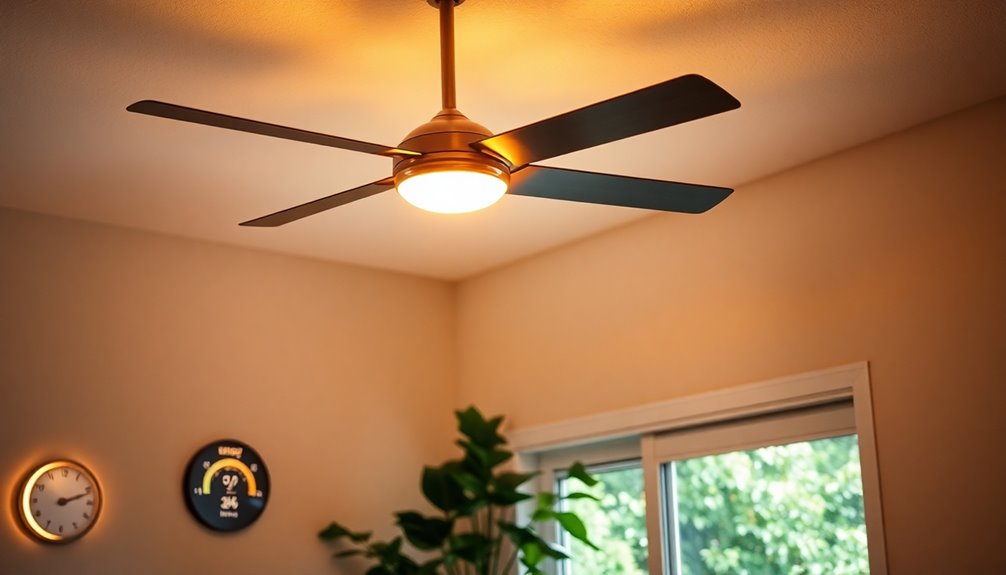
Several factors can influence the energy efficiency of your ceiling fan, impacting both performance and operating costs.
The wattage of your fan plays a notable role; energy-efficient models can run on as little as 30 watts, while larger fans may consume 55 to 100 watts due to their airflow capacity.
The duration of fan usage also matters—running a fan for 12 hours a day will boost power consumption compared to just 4 hours.
Additionally, wiring quality and motor type affect energy efficiency; well-designed fans use less power while delivering better airflow. Moreover, proper insulation and sealing can prevent energy loss, maximizing overall efficiency in your home environment.
Ceiling Fan Wattage by Size
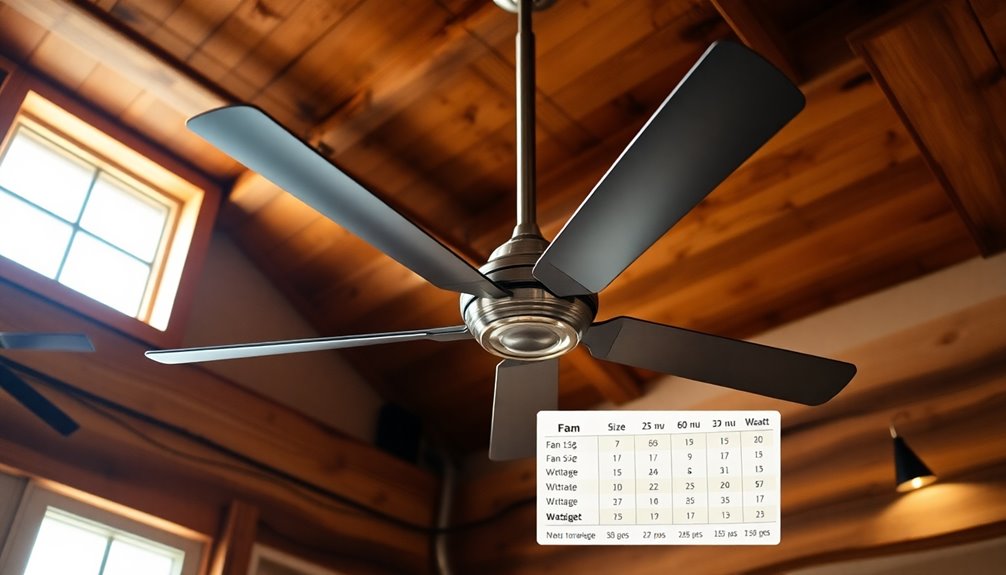
- Small Rooms: A 30-inch ceiling fan typically consumes about 48 watts, perfect for small spaces.
- Medium Spaces: The average wattage for a 48-inch ceiling fan is around 75 watts, balancing airflow and efficiency.
- Larger Fans: For a 52-inch ceiling fan, power consumption ranges from 85 to 90 watts, while a 60-inch ceiling fan may exceed 100 watts. Regular maintenance can prevent dangerous situations related to mechanical failure and inefficiencies.
Choosing the right size guarantees maximum energy efficiency and cooling performance, helping you enjoy comfort without excessive energy costs.
Tips for Reducing Energy Consumption
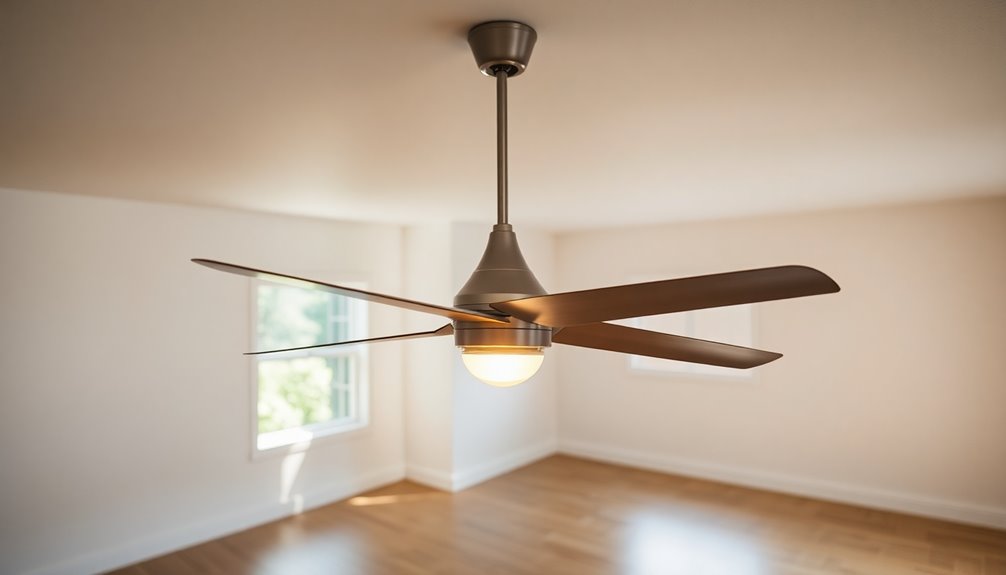
While enjoying the comfort of a ceiling fan, you can easily reduce energy consumption with a few simple strategies.
First, run your fan on low speed; it can reduce power consumption by 20-30%, maximizing efficiency.
Remember to turn off the fan when you leave a room; this can save you about $0.14 per day, leading to significant monthly savings.
Opt for an energy-efficient ceiling fan, which can lower ceiling fans wattage from 75 watts to as low as 30 watts, cutting down on electricity costs.
Set your thermostat higher while using fans to reduce cooling costs by up to 30%.
Finally, regular maintenance, like cleaning blades, enhances airflow and may save you an additional 10% on energy bills.
Frequently Asked Questions
How Many Watts Does a Ceiling Fan Take?
When you're looking at ceiling fans, the wattage can vary quite a bit.
Generally, you'll find that most fans use between 55 to 100 watts, with a common average around 75 watts.
Smaller models, like a 24-inch fan, might only consume about 41 watts, while larger ones can go up to 180 watts.
Always check the label or manual for the specific wattage of the fan you're considering.
How Many Watts Does a Ceiling Fan Pull?
Imagine your ceiling fan whirring gently overhead, creating a cool breeze.
So, how many watts does it pull? Depending on the size and model, you're looking at anywhere from 30 to 180 watts.
A standard 48-inch fan usually pulls about 75 watts, while smaller ones can be more energy-efficient.
How Many Watts Does a 52 Inch Ceiling Fan Use?
A typical 52-inch ceiling fan uses around 90 watts during operation, though this can vary by brand and model.
If you run it for 12 hours a day, you'll consume about 1.08 kWh daily, which adds up to roughly 32.4 kWh over a month.
This could cost you around $7.45, depending on your local electricity rates.
Energy-efficient models can use as little as 75 watts, saving you money on electricity bills.
How Much Does It Cost to Run a Ceiling Fan 24 7?
Running a ceiling fan 24/7 can cost you between $0.42 and $0.55 per day, depending on the wattage.
For a typical 75-watt fan, you'll spend about $12.42 monthly, while a 100-watt fan adds up to around $16.50.
Over a year, that's roughly $151.56 for the 75-watt and $198.00 for the 100-watt.
Conclusion
In summary, understanding ceiling fan wattage helps you make smarter choices for your home. By considering size, energy costs, and efficiency factors, you can enjoy comfort without breaking the bank. Isn't it great to know that you can keep cool while being energy savvy? By following the tips for reducing energy consumption, you'll not only save money but also contribute to a greener planet. So go ahead, turn on that fan and enjoy the breeze!
